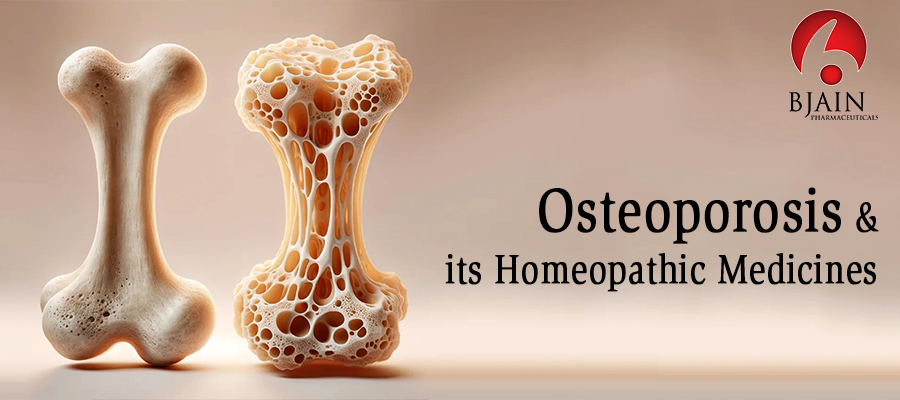Osteoporosis can be defined as the deterioration of bones that can lead to fragility and vulnerability to breaks. In this disorder, people frequently experience slow progressive damage and they tend to experience no change until a bone breaks by a trivial accident. Homeopathy works in a holistic way that addresses its underlying cause and treats a disorder inside out. It tackles the root causes making the best solution for osteoporosis.
The “quiet illness” is something similar to an iceberg. You can’t see much of the issue because it is hidden in its slow progression until you hit it. The reduction in bone density makes it prone to bone fractures and reduces its endurance. The most commonly affected joints are the vertebral column, hip joint, and wrists. The prime cause behind the progression of Osteoporosis is increased bone resorption and decreased bone development leading to reduced bone mass and structural degeneration. Older people above the age of 65 are most commonly affected, especially post-menopausal women. While it has been generalized we can see osteoporosis in the younger population as well for a variety of reasons.
Homeopathic treatments stimulate inner mechanisms to improve bone condition while also restoring equilibrium. This comprehensive approach supports traditional therapies and can be incorporated into an overall osteoporosis care strategy.
What are the symptoms of Osteoporosis?
Osteoporosis can be present without any apparent sign until a person experiences their first bone fracture. The most typical signs of osteoporosis are:
- Fractures happen with little or no stress, usually in the vertebral column, hip, or wrist.
- Backaches can be chronic or abrupt, resulting from broken vertebrae or compression.
- Height loss: Spinal fractures resulting from compression cause a progressive decline in height as time passes.
- Posture shifts: Spinal abnormalities cause a slumped or stooped posture (kyphosis).
- Bone soreness is soreness or discomfort in the bones or joints, especially after a slight trauma.
What are the causes of Osteoporosis?
Osteoporosis results from a disparity between bone loss and bone production. Key reasons and important variables are:
- Aging: Bone mass normally diminishes with age, notably in postmenopausal women, and with increasing age in men and women.
- Hormonal changes: Low estrogen concentrations in women and testosterone in males might lead to bone resorption.
- A lack of nutrition includes insufficient calcium and vitamin D intake, both of which are necessary for healthy bones.
- An inactive lifestyle: Inadequate weightlifting activities might damage bones gradually.
- Health factors: Autoimmune diseases, thyroid issues, and digestive ailments can all have an impact on bone strength.
- Drugs: Prolonged use of steroid drugs and other drugs can raise the possibility of osteoporosis.
What are the Risk Factors of Osteoporosis?
Numerous variables can raise the chance of having osteoporosis, such as:
- Age: Incidence elevates with age, especially after menopause in females.
- Women are more prone than males to fall victim to osteoporosis, particularly after menopause.
- A familial record of osteoporosis or broken bones could raise chances.
- People with a petite physical structure may be at greater risk due to their lower bone density.
- Behavioral habits that lead to bone loss include tobacco use, heavy alcohol intake, and being idle.
- Health care history: Hyperthyroidism, autoimmune disorders, and digestive disorders can have an impact on bone wellness.
What are the Complications associated with Osteoporosis?
Osteoporosis can cause many problems, including:
- Fractures: There is a higher chance of fractures, notably in the spinal column, hips, and wrists.
- Chronic pain: discomfort that persists after a vertebral fracture or any other bone injury.
- Mobility loss refers to a reduced capacity to move or carry out everyday tasks as a result of fractures or bone discomfort.
- Spinal abnormalities, such as kyphosis, can arise from backbone fractures that are compressed.
- Impaired standard of life: This affects bodily function, autonomy, and general quality of life.
How can we prevent it?
Preventing osteoporosis entails making modifications to your lifestyle and implementing techniques to preserve bone health:
- Adequate nutrition: Consume sufficient quantities of vitamin D and calcium via food or supplements.
- Weight-bearing workouts: To build up your bones, perform consistent weightlifting and resistance workouts.
- Healthy living includes not smoking, limiting alcohol intake, and eating a well-balanced diet.
- Bone density monitoring entails frequent bone density testing for anyone vulnerable above the age of 65.
- Sticking to the recommended treatments and drugs is essential for maintaining bone health and preventing osteoporosis.
How can we diagnose Osteoporosis?
There are various processes involved in identifying osteoporosis.
- Medical history: Discuss indicators, risk variables, and past health history with a physician.
- A physical exam: Evaluation of bone condition, alignment, and the presence of fractures or abnormalities.
- Bone density test: A double-energy X-ray absorptiometry (DEXA) exam to determine bone mass and detect osteoporosis.
- Blood tests to determine calcium, vitamin D status, and resorption indicators.
What are the best Homeopathic remedies for Osteoporosis?
Homeopathic medicines can supplement traditional osteoporosis therapies by improving general bone wellness and alleviating particular symptoms. Some often-used medicines are:
- Omeo Calcium (tablets): It is a one-of-a-kind homeopathic remedy made out of well-known homeopathic medicines that helps boost the absorption of calcium in the system. It is also useful in malnutrition of bones and growing pains.
- Calcarea carbonica: Beneficial for those with fragile bones, repeated fractures, and a predisposition to bone discomfort, particularly in joints and the vertebral column.
- Silicea is beneficial to persons with thin bones, poor rehabilitation of bones, and past experiences of fractures. It enables one to build bones and increase bone mass.
- Phosphorus: Beneficial for those who have osteopenia or osteoporosis who are experiencing aching bones, particularly when the discomfort worsens at night.
- Lachesis: Recommended for people who have significant painful bones and edema, especially if the symptoms increase with warmth and improve with cold packs.
- Arnica montana is useful for reducing pain and bruises caused by cracks or broken bones.
Conclusion:
Women are at greater risk of developing osteoporosis in advanced age. It happens due to depletion of bone density and it can lead to frequent fractures and growing pains. Estrogen reduction in post-menopausal females is an important reason behind such deficiencies. Homeopathy can help manage this condition by boosting calcium absorption and establishing harmony in the body. Homeopathy works by correcting the underlying issue behind the surface disease and holistically helps you.

Dr Aditi
Dr Aditi (BHMS) from NHMC Delhi, HMO ( Chandigarh Administration), Ex- SRF ( CCRH ), currently doing a research study of effect of Homoeopathic medicines in Mother and Child Health care in Chandigarh.


